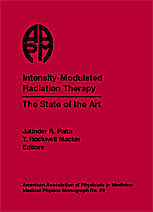
#29 Intensity-Modulated Radiation Therapy: The State of the Art
Author: Jatinder R. Palta and T. Rockwell Mackie, editorsISBN: 9781930524163 ISBN10: 1930524161
Published: 2003 | 904 pp. | Hardcover
Price: $ 44.95 was 100.00
Physics in Medicine and Biology | January 2004
"This book represents the proceedings of the five day programme on IMRT techniques presented at the 2003 American Association of Physicists in Medicine (AAPM) Summer School held in Colorado Springs, Colorado. The book is essentially an overview of IMRT techniques, discussing the history, the mathematical processes involved in the planning stages, the biological indices for evaluations, the off-line and on-line medical imaging that is required, the various IMRT delivery techniques available, positioning and motion verification, shielding and QA issues, and some clinical applications. There is some additional discussion on modulated electron and proton therapy, views on the clinical and financial impact of IMRT, as well as some speculation on the future uses of IMRT. The fact that the book is an 'overview' must be emphasized. Medical physicists who are well-read in IMRT, or have implemented IMRT, even partially, may be a little disappointed with the book. Although specific details were purposely omitted, the well-read physicist would have preferred to go right to the 'heart of the matter', something this book fails to do.
"As is typical of many proceedings-type books, there is a certain level of inconsistency of writing styles, as well as some redundancy between the different chapters. It is unfortunate that such a large volume does not have an index to allow a reader to explore a particular subject pertaining to IMRT. The reader would have to guide himself/herself by the table of contents before each chapter which could be a problem if the reader requires some information quickly.
"It is interesting to note that the book lends itself to a variety of professionals interested in IMRT, including administrators. It may be a source of help for medical physicists who wish to discuss IMRT issues with higher level administration, for example. Some clinical applications are also reviewed. The lack of details concerning the advantages of IMRT with respect to clinical outcome is probably due to the fact that IMRT is a rather new technology, and there is not sufficient data to perform a comprehensive comparison to more conventional techniques. However, even a speculative discussion on the possible theoretical advantages of IMRT at the clinical or radiobiological level would have been interesting. It is unfortunate, but the question as to whether all of this technology is worth the clinical outcome has, unfortunately, not really been addressed. One can, however, appreciate the difficulties by admitting, again, that IMRT is still a rather novel technique and more time is required to consider these issues appropriately.
"The book is an obvious reference source for all practical aspects of IMRT implementations. In particular, there are some interesting discussions on some of the practical issues concerning the pitfalls in commissioning linacs and optimization systems for IMRT, the practical limitations to optimization, and IMRT QA issues and procedures. These discussions are crucial to the implementation of IMRT. Other discussions refer to patient-positioning issues, and the various techniques, albeit not all fully developed, with which these issues can be addressed. It would be very difficult, if not impossible, at the present time, to develop a 'textbook' on IMRT because IMRT is such a novel technique. However, the present book can certainly be an aid to an instructor as it also contains a CD of the chapters in Acrobat format, some chapter figures in colour, and quite an interesting selection of movie clips to supplement one of the chapters.
"In summary, the book can be considered a worthwhile reference in the fast-changing field of IMRT, and should be part of any medical physics library as supplemental reading material for medical physics graduate students, medical physics residents studying for certification, and practising medial physicsts who wish to implement IMRT in the clinic."
-B.G. Fallone
Cross Cancer Institute
University of Alberta


